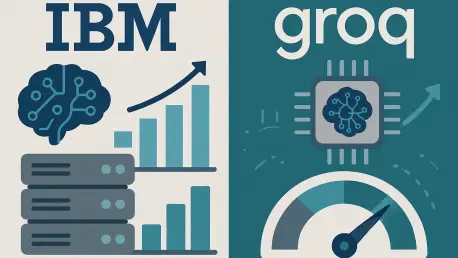In an era where artificial intelligence is redefining enterprise operations, the demand for faster, more cost-effective solutions has never been more pressing, especially as global spending on AI is projected to surpass $300 billion by 2026. Businesses across industries are grappling with the challenge of scaling complex models without breaking budgets or sacrificing performance. This market analysis delves into the strategic partnership between IBM and Groq, announced in late 2024, which promises to reshape the AI inferencing landscape. By integrating Groq’s cutting-edge hardware into IBM’s robust ecosystem, this collaboration addresses critical bottlenecks in speed and cost, offering a glimpse into the future of enterprise AI. The purpose of this examination is to uncover the market trends driving such alliances, evaluate their impact on key sectors, and project how they might influence competitive dynamics in the years ahead.
Dissecting Market Trends in AI Inferencing
The Surge in Demand for Real-Time AI Solutions
The AI market is witnessing an unprecedented push for real-time processing capabilities, particularly in sectors like healthcare, finance, and retail. Applications such as fraud detection systems, customer service automation, and IoT-driven monitoring require split-second decision-making, where latency can mean the difference between success and failure. IBM’s integration of Groq’s Language Processing Unit (LPU) technology, which boasts over five times faster inferencing compared to traditional GPU systems, taps directly into this need. This trend reflects a broader shift in enterprise priorities, as companies seek hardware innovations to keep pace with growing data volumes and user expectations. Market data suggests that the demand for specialized AI hardware could grow at a compound annual rate of over 25% from 2025 to 2027, signaling a robust opportunity for partnerships like this one.
Cost Pressures Reshaping AI Adoption Strategies
Another dominant force in the AI market is the escalating cost of computational resources, which often hinders large-scale deployment. Traditional GPU-based systems, while powerful, come with high operational expenses, especially for industries managing high-volume workloads like financial services and manufacturing. Groq’s promise of significant cost reductions through its inference platform, now embedded in IBM’s watsonx Orchestrate, positions this alliance as a potential game-changer. Enterprises stand to benefit from optimized budgets without compromising on performance, a critical factor as AI budgets tighten under economic scrutiny. However, market observers note that adoption hurdles, such as integration complexities, could temper short-term gains, necessitating a careful balance between innovation and practicality in deployment strategies.
Ecosystem Expansion and the Role of Open-Source Integration
A notable trend shaping the AI landscape is the move toward diverse, interoperable ecosystems that cater to varied enterprise needs. IBM’s collaboration with Groq extends beyond hardware, enhancing compatibility with open-source frameworks like Red Hat’s large language model (vLLM) and supporting IBM’s own Granite models on GroqCloud. This focus on orchestration and hardware acceleration underscores a market shift toward flexibility, allowing businesses to customize AI solutions across regions and sectors. Analysts predict that such integrations could disrupt conventional AI deployment models, as enterprises increasingly favor vendors offering seamless, scalable options. The challenge lies in overcoming misconceptions about specialized hardware complexity, which could slow market penetration if not addressed through robust support and education.
Projecting the Future of Enterprise AI Markets
Rise of Specialized Hardware as a Market Differentiator
Looking ahead, specialized hardware like Groq’s LPU is poised to carve out a significant niche in the AI market, moving away from the dominance of general-purpose GPUs. This trend points to a future where tailored architectures become essential for high-performance tasks, particularly in real-time inferencing. Market projections indicate that by 2027, nearly 40% of enterprise AI workloads could rely on such bespoke solutions, driven by the need for efficiency and precision. IBM’s strategic alignment with Groq places it at the forefront of this shift, potentially redefining competitive benchmarks for other tech giants. Yet, regulatory considerations around data security and ethical AI use may shape how quickly this hardware gains traction across global markets.
Collaborative Ecosystems as a Growth Catalyst
The AI market is also trending toward collaborative ecosystems, where partnerships between established players and innovative startups fuel growth. IBM’s multi-faceted approach, evident in its alliances with Groq and other entities like Anthropic, reflects a broader industry movement to offer diverse AI tools and models. This strategy not only enhances market reach but also mitigates risks associated with over-reliance on a single technology. Forecasts suggest that such collaborative models could drive a 30% increase in enterprise AI adoption rates over the next few years, as businesses prioritize vendors with comprehensive, adaptable offerings. The key to sustaining this momentum will be ensuring scalability and governance in increasingly complex AI environments.
Impact on Industry-Specific AI Investments
Finally, the partnership’s implications extend to industry-specific investment patterns, particularly in high-stakes sectors. Healthcare organizations, for instance, could channel more resources into AI-driven diagnostics with faster inferencing, while financial institutions might double down on real-time risk assessment tools. Retail and government sectors, reliant on rapid customer and operational insights, are also likely to see accelerated AI investments fueled by cost-efficient solutions. Market analysis indicates that these industries could collectively account for over half of the specialized AI hardware market by 2027, highlighting the targeted impact of innovations like those from IBM and Groq. Monitoring these investment shifts will be crucial for understanding broader market evolution.
Reflecting on Market Insights and Strategic Pathways
Looking back, the analysis of IBM’s partnership with Groq reveals a transformative moment in the enterprise AI market, addressing critical needs for speed and affordability through innovative hardware integration. The collaboration stands as a testament to the power of strategic alliances in overcoming longstanding performance barriers, while IBM’s broader ecosystem approach underscores the value of versatility in a competitive landscape. For businesses navigating this evolving terrain, the next steps involve exploring hybrid AI platforms that blend specialized technologies with customizable workflows. Stakeholders are encouraged to prioritize partnerships that balance scalability with cost efficiency, while keeping an eye on emerging hardware trends to stay ahead. Ultimately, the focus shifts to building adaptive strategies that can harness these advancements for sustained market advantage.









